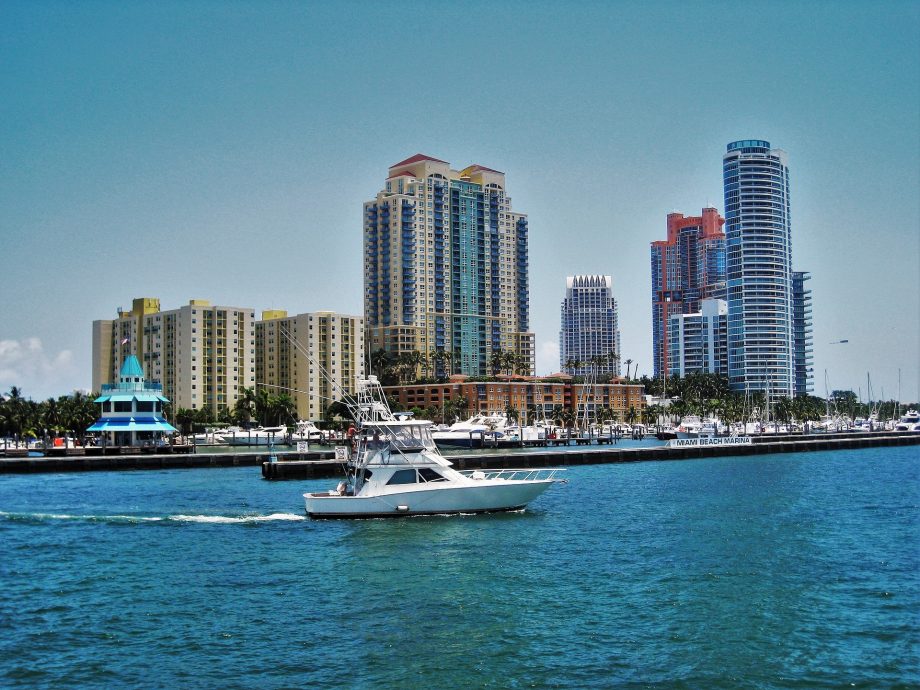Bouncin’ in the club where the heat is on, all night on the beach ’til the break of dawn, I’m going to Miami, welcome to Miami.
So spoke the rapper Will Smith in his hit ditty Miami back in 1997, but we assumed you might need a little more information on this Floridian seaport.
Voted America’s cleanest city, nicknamed the Capital of Latin America and an economic powerhouse in the modern American landscape, there’s a lot more to this famous metropolis than Don Johnson in a white suit and Gloria Estefan.
Miami History
Miami takes its name from the Mayaimi tribe of Native Americans who lived on the land until the 18th Century. In its earlier years, the city was subject to disputes between the French and Spanish.
Rapid expansion began at the end of the 19th Century, and the city continued to grow in stature. Like the rest of America, Miami suffered through the great depression, but it gained a new lease of life throughout WWII, with Franklin D. Roosevelt using the city as a military base to guard Florida’s water-based entry points.
Hotels were converted to military bases, and many soldiers decided to stay in Miami after peace was declared, swelling its population considerably.
Cuban immigration began en masse in the 1960s, and continues to this day.
The city of Miami underwent further huge growth in the 1980s, but financial problems followed in the 1990s following Hurricane Andrew.
Redevelopment, along with the election of mayor Manny Diaz, led to a rebirth in the early 2000s, and Miami has since become an economic powerhouse on a global scale.
Miami as a remote work destination for digital nomads
A few things to keep in mind when considering Miami as a remote work / digital nomad destination.
Firstly, Miami is not all business when compared to other major US cities like New York or Chicago. It has a more relaxed / vacation vibe so it’s more the place to go if you want to work and also unwind at the same time.
Miami is an expensive city so be prepared to shell out if you want to be anywhere near the water.
Miami has a whole host of co-working spaces and laptop-friendly cafes where you can get your work done before hitting a rooftop bar for a cocktail.
The real estate specialist, Savills put Miami in the top three places to go for remote work, alongside Lisbon in Portugal and Dubai in the United Arab Emirates.
Language and Climate in Miami
Miami’s dialect is so distinctive that it has been dubbed ‘The Miami Accent’. A result of the large number of Hispanic immigrants post-WWII, with second- and third-generation Miamians growing up bilingual, the Miami accent is predominantly American English with a pinch of Spanish and long, enunciated vowels.
Young Miamians also have a very distinct slang dialect, so you may need to brush up on a little lingo before interacting with the locals.
Miami is a tropical city, so the high temperatures are scorchio and there’s a season of heavy rain that lasts from May right through until October (travelling outside of this period will ramp up the costs of your trip considerably).
Humidity is often through the roof at these points, and broken up by thunderstorms. On the plus side, temperatures haven’t reached freezing since the 1980s, and snow has only been spotted once, in the 1970s – and even then the claims are disputed.
Where to Stay in Miami
Well, that depends – beach or city? If you don’t have a car and are averse to taking cabs, you’ll have to choose one or the other to spend the majority of your time in.
The beach districts are a little quieter, but you’ll still find plenty to eat, drink and do on these sandy escapes.
Miami Beach and South Beach are home to beautiful golden sands and clear blue skies and seas.
If you head downtown you’ll find Little Havana and Little Haiti, home to the Cuban and Haitian communities (with the laid-back Caribbean lifestyle that suggests), and Wynwood, one of the more up-and-coming districts with plenty of nightlife.
Coconut Grove is a little more bohemian, though it’s increasingly gentrified and now acts as a haven for shoppers.
Key Biscayne, meanwhile, is the perfect spot for families and watersport enthusiasts, and north Miami hosts Liberty City, a key district in black history.
Getting Around Miami
Unlike most of the United States, Miami doesn’t have a particularly straightforward road grid. Rather than the “straight on for eight blocks, left, right at the sixth block” directions you may receive elsewhere, this city is home to more twists and turns than a plate of spaghetti.
Hiring a car is probably advisable if you’re comfortable with the idea as there is no public transport between the beach and the city centre. Just be warned, the authorities in Miami (especially the beach) are very stringent on parking policies, and will tow your car away without a second thought if you contravene the laws of the land.
The good news is, Miami does have a public transport network. The bad news? It isn’t brilliant, and requires some planning ahead. The first thing you should do is install the Miami-Dade Transit Tracker app to your smartphone, which will fill you in on schedules for buses and trains.
The Metrobus covers the full city in a cost-effective manner, with fares starting at just $2.25, but punctuality is not a strong point. There’s also a Metrorail, but this is more commuter-focused and acts more like a park-and-ride – the stations are out of the way, and don’t stop at many tourist destinations. The Metromover is free and handy, transporting people throughout the city centre, but again doesn’t tend to venture to the trendier emerging nightspots.
Miami isn’t entirely pedestrian- or cycle-friendly, though steps are being taken, but thankfully cabs, Uber and Lyft cars are plentiful.
Culture and Attractions in Miami
There’s more to Miami than relaxing on the beach, tempting though it may be to lay claim to a towel and stay put with a cocktail. The Miami Sound Machine tried to warn you that the rhythm is gonna get ya, and Miami has a vibrant culture of dance. Dance NOW! Miami and the Momentum Dance Company offer both education and performance, and ballet is a major part of the city’s cultural landscape.
Ballet Flamenco La Rosa, the Arts Ballet Theater of Florida and the Miami City Ballet will provide your fill of tights and tutus. The Florida Grand Opera also operates out of Miami, alongside ten multi-part orchestras, or you can try out one of the many, many performing arts theaters.
If film is more your bag then investigate the many cinemas and film festivals, including the IMAX on Lincoln Road. Alternatively, you can investigate one of the dozen museums (including the Pérez Art Museum, History Miami, the Haitian Heritage Museum and the Jewish Museum of Florida) or nine art galleries.
Of course, one of Miamians biggest passions are two-time Super Bowl champions the Miami Dolphins, who ply their trade at the 80,120-capacity Hard Rock Stadium. A soccer team, backed by the chequebook of David Beckham, is under construction, but other successful teams are in operation; the Miami Marlin’s baseball team has won the World Series twice, and Miami Heat have reached three NBA finals.
Eating out in Miami
With almost a third of Miami’s population hailing from Cuba, it’s no surprise that Caribbean cuisine plays a major part in the city’s food scene. Blending with more traditional American influences to create a movement referred to as Florribean, trademark dishes include sandwiches such as the Cuban and the Medianoche. Seafood is plentiful, with stone crab being a particular favourite of Miamians, and cocktails such as Mojitos, Mango Martini, Cuba Libre and Café con Leche all originated in the city. If you’re looking for something a little speedier, don’t panic – Burger King HQ is also based in Miami.


